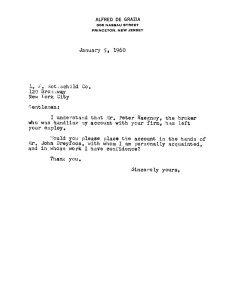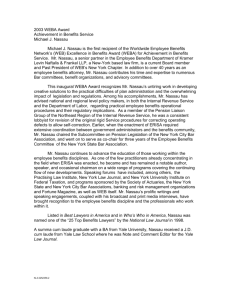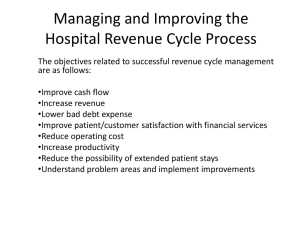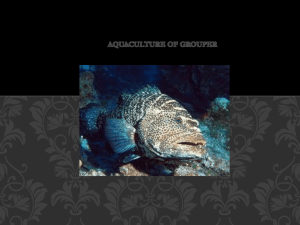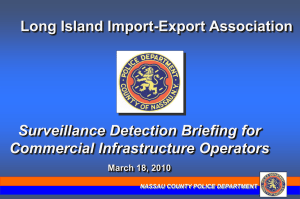PDF Version
advertisement
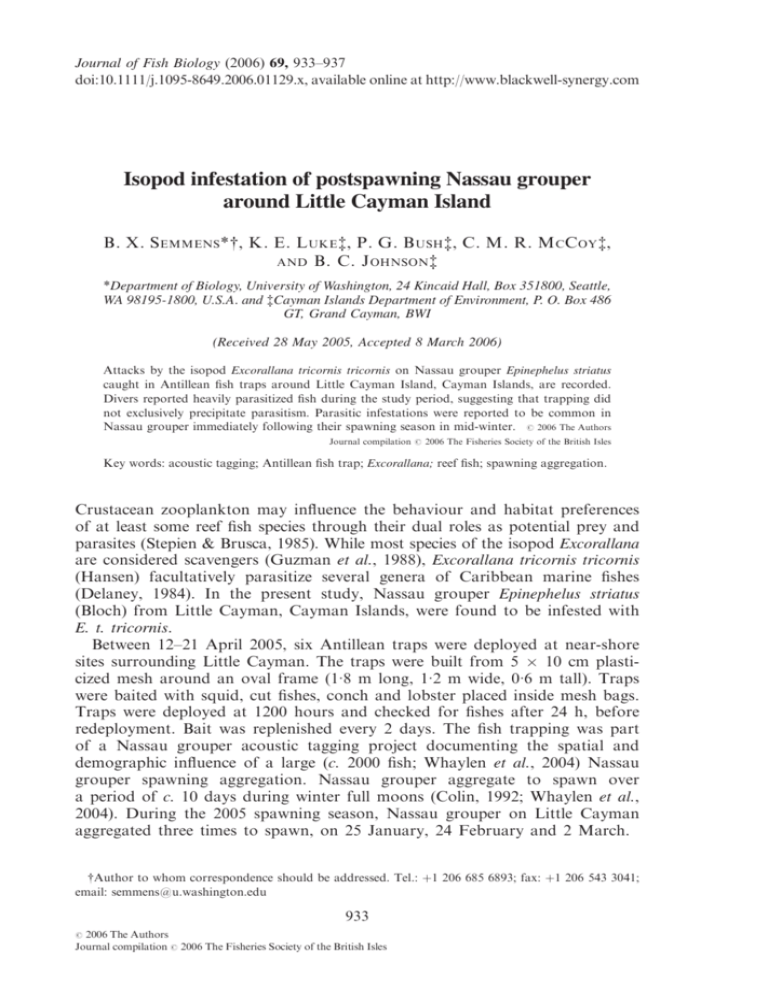
Journal of Fish Biology (2006) 69, 933–937 doi:10.1111/j.1095-8649.2006.01129.x, available online at http://www.blackwell-synergy.com Isopod infestation of postspawning Nassau grouper around Little Cayman Island B. X. S EMMENS *†, K. E. L UKE ‡, P. G. B USH ‡, C. M. R. M C C OY ‡, AND B. C. J OHNSON ‡ *Department of Biology, University of Washington, 24 Kincaid Hall, Box 351800, Seattle, WA 98195-1800, U.S.A. and ‡Cayman Islands Department of Environment, P. O. Box 486 GT, Grand Cayman, BWI (Received 28 May 2005, Accepted 8 March 2006) Attacks by the isopod Excorallana tricornis tricornis on Nassau grouper Epinephelus striatus caught in Antillean fish traps around Little Cayman Island, Cayman Islands, are recorded. Divers reported heavily parasitized fish during the study period, suggesting that trapping did not exclusively precipitate parasitism. Parasitic infestations were reported to be common in Nassau grouper immediately following their spawning season in mid-winter. # 2006 The Authors Journal compilation # 2006 The Fisheries Society of the British Isles Key words: acoustic tagging; Antillean fish trap; Excorallana; reef fish; spawning aggregation. Crustacean zooplankton may influence the behaviour and habitat preferences of at least some reef fish species through their dual roles as potential prey and parasites (Stepien & Brusca, 1985). While most species of the isopod Excorallana are considered scavengers (Guzman et al., 1988), Excorallana tricornis tricornis (Hansen) facultatively parasitize several genera of Caribbean marine fishes (Delaney, 1984). In the present study, Nassau grouper Epinephelus striatus (Bloch) from Little Cayman, Cayman Islands, were found to be infested with E. t. tricornis. Between 12–21 April 2005, six Antillean traps were deployed at near-shore sites surrounding Little Cayman. The traps were built from 5 10 cm plasticized mesh around an oval frame (18 m long, 12 m wide, 06 m tall). Traps were baited with squid, cut fishes, conch and lobster placed inside mesh bags. Traps were deployed at 1200 hours and checked for fishes after 24 h, before redeployment. Bait was replenished every 2 days. The fish trapping was part of a Nassau grouper acoustic tagging project documenting the spatial and demographic influence of a large (c. 2000 fish; Whaylen et al., 2004) Nassau grouper spawning aggregation. Nassau grouper aggregate to spawn over a period of c. 10 days during winter full moons (Colin, 1992; Whaylen et al., 2004). During the 2005 spawning season, Nassau grouper on Little Cayman aggregated three times to spawn, on 25 January, 24 February and 2 March. †Author to whom correspondence should be addressed. Tel.: þ1 206 685 6893; fax: þ1 206 543 3041; email: semmens@u.washington.edu 933 2006 The Authors Journal compilation # 2006 The Fisheries Society of the British Isles # 934 B. X. SEMMENS ET AL. Each trap was set for c. 229 h, accumulating 1373 of trapping h and yielding 51 fishes, including 21 Nassau grouper (Table I). Approximately, half of the Nassau grouper caught were infested with isopods (Fig. 1); two were found dead in the traps. Larger (>50 cm fork length, LF) Nassau grouper were more likely to be infested than smaller (<50 cm LF) individuals (Table I; w2, d.f. ¼ 1, P < 001). During the first 2 days of trap recovery, infested individuals were brought to the surface. Subsequently, divers released infested individuals from the traps. Individuals were apparently physically and behaviourally affected by the infestation. Most exhibited cloudy eyes, patches of discolouration, lethargy and disorientation. Infested individuals were sluggish when approached by divers and, when released, swam only a short distance before settling on the substratum. One individual released from a trap at 30 m swam to the surface. Isopods were collected from two different Nassau grouper on subsequent days, and preserved in 95% ethanol for identification. All preserved individuals were identified as E. t. tricornis. During the season’s first of three spawning periods (25 January 2004 to 3 February 2004), 81 Nassau grouper were caught on hook and line for tagging; none was infested with E. t. tricornis. TABLE I. Catches from modified Antillean fish traps deployed for 1373 h including each species caught, along with the number of individuals captured, the number of individuals with conspicuous and ongoing attacks by Excorallana tricornis tricornis and the number of fishes found dead. Note that Nassau grouper are split into two rows, representing individuals >50 cm LF (large enough to tag, and probably reproductively active) and fish <50 cm LF (too small for tagging, and possibly not sexually mature) Species Number caught Number infested Number dead 13 9 2 Nassau grouper Yellowfin grouper Tiger grouper 7 2 1 0 0 1 1* 0 0 White margate Mutton snapper Schoolmaster snapper 5 1 1 0 0 0 0 0 0 Ocean trigger 1 0 0 Queen trigger Spotted trunkfish Bar jack Nurse shark 9 2 1 6 0 0 0 0 0 1 0 1 Green moray 2 0 0 Common name Epinephelus striatus (Bloch) >50 cm LF E. striatus <50 cm LF Mycteroperca venenosa (L.) Mycteroperca tigris (Valenciennes) Haemulon album Cuvier Lutjanus analis (Cuvier) Lutjanus apodus (Walbaum) Canthidermis sufflamen (Mitchill) Balistes vetula L. Lactophrys bicaudalis (L.) Caranx ruber (Bloch) Ginglymostoma cirratum (Bonnaterre) Gymnothorax funebris Ranzani Nassau grouper *This individual was found dead in the trap with the tail and rear portion of the body bitten off. A shark probably attacked the fish while its tail was through the trap mesh. LF, fork length. Journal compilation # # 2006 The Authors 2006 The Fisheries Society of the British Isles, Journal of Fish Biology 2006, 69, 933–937 ISOPOD INFESTATION OF POSTSPAWNING GROUPER 935 FIG. 1. Nassau grouper infested with E. t. tricornis. The highest densities of the isopods were found in (a) the folds of the mouth, nasal cavities, eye sockets and mouth and (b) the throat and gills. While trap confinement may have increased the likelihood and magnitude of infestation, it was not the exclusive cause. Stepien & Brusca (1985) documented nocturnal attacks on caged temperate marine fishes by isopods and concluded that the attacks occurred because confinement restricted normal escape mechanisms. Antillean fish traps undoubtedly impede normal modes of escape; moreover, trapped fishes are unable to visit cleaning stations. If traps primarily or exclusively precipitated the heavy parasite loads, healthy Nassau grouper could be expected outside the traps. Once it became apparent that most of the larger, trap-caught Nassau grouper were infested with E. t. tricornis, local fishermen and dive professionals were consulted regarding the infestation. Nassau grouper are not targeted by fishermen in the Cayman Islands immediately following spawning (February to April) because they tend to be heavily parasitized and their flesh is ‘soft and unmarketable’. Divers reported seeing some Nassau grouper with conspicuous and heavy isopod infestations that were ‘obviously very unhealthy’. Based on these reports, it is unlikely that the E. t. tricornis attacks on Nassau grouper were solely due to trapping. The perception that postspawning Nassau grouper are heavily infested, and generally unhealthy, is supported by the fact that larger, trap-caught spawning fish caught were infested whereas smaller, prespawning trap-caught fish (Table I) were not infested. If the fishermen are correct, the costs to this species associated with spawning may be of sufficient magnitude that a high degree of behavioural ‘choosiness’ regarding whether and when to release gametes might be expected. Moreover, recent observational studies suggest that fish in small aggregations (<100 fish) do not spawn (Gascoigne & Elliot, 2002). The conservation of Nassau grouper spawning aggregations is a matter of concern not only because aggregations are easily targeted by fishermen but also because once aggregations have been fished to exhaustion (e.g. Florida Keys and Bermuda) the species has failed to recover, despite decades of subsequent protection (Cornish & Eklund, 2003). Parasite avoidance and behavioural infection-reducing mechanisms are one aspect of the evolving ‘arms race’ between parasites and hosts (Dawkins & Krebs, 1979; Barber et al., 2000). # 2006 The Authors Journal compilation # 2006 The Fisheries Society of the British Isles, Journal of Fish Biology 2006, 69, 933–937 936 B. X. SEMMENS ET AL. Host evolution maximizes the chance of reaching reproductive age, and, more generally, its overall individual lifetime reproductive potential (Poulin et al., 1994). Thus, behavioural parasite-avoidance mechanisms are likely regardless of current parasite loads; host behaviour reflects the potential future costs of parasitism. If the energetic and physiological expense of reproduction exposes individual Nassau grouper to higher levels of parasitism (and ultimately higher mortality rates), the perceived reproductive benefits of gamete release on small aggregations with limited mate choice may well be outweighed by the lifetime fitness costs associated with spawning. Such behavioural ‘decisions’ are tantamount to an Allee effect (Allee, 1931) and could partially explain the lack of spawning by small aggregations and the failure of highly depressed stocks to recover. The authors thank B. Luckhurst and T. Trott for field help, and P. Hillenbrand for logistical support. R. Brusca identified the isopod and provided formative ideas and guidance regarding this paper. Funding for the project was provided in part by the Department of Commerce (DOC), National Oceanographic and Atmospheric Administration (NOAA) Coral Reef Conservation Fund [award number NA04NOS4630287] and the PADI Project AWARE Foundation. B.X.S. was supported by a Science To Achieve Results United States Environmental Protection Agency (EPA) graduate research fellowship. The statements, findings and conclusions in this report are those of the authors and do not necessarily reflect the views of DOC, NOAA or EPA. Special thanks to the Reef Environmental Education Foundation (REEF) and REEF volunteers for facilitating this research. References Allee, W. C. (1931). Animal Aggregations. A Study in General Sociology. Chicago, IL: University of Chicago Press. Barber, I., Hoare, D. & Krause, J. (2000). The effects of parasites on fish behaviour: an evolutionary perspective and review. Reviews in Fish Biology and Fisheries 10, 131–165. Colin, P. L. (1992). Reproduction of the Nassau grouper, Epinephelus striatus (Pisces: Serranidae) and its relationship to environmental conditions. Environmental Biology of Fishes 34, 357–377. Dawkins, R. & Krebs, J. R. (1979). Arms races between and within species. Proceedings of the Royal Society of London B 205, 489–511. Delaney, P. M. (1984). Isopods of the genus Excorallana Stebbing, 1904 from the Gulf of California, Mexico (Crustacea, Isopoda, Corallanidae). Bulletin of Marine Science 34, 1–20. Guzman, H. M., Obando, V. L., Brusca, R. M. & Delaney, P. M. (1988). Aspects of population biology of the marine isopod Excorallana tricornis occidentalis Richardson, 1905 (Crustacea: Isopoda: Corallanidae) at Cano Island, Pacific Costa Rica. Bulletin of Marine Science 43, 77–87. Poulin, R., Brodeur, J. & Moore, J. (1994). Parasite manipulation of host behaviour— should hosts always lose? Oikos 70, 479–484. Stepien, C. A. & Brusca, R. M. (1985). Nocturnal attacks on nearshore fishes in southern California by crustacean zooplankton. Marine Ecology Progress Series 25, 91–105. Whaylen, L., Pattengill-Semmens, C. V., Semmens, B. X., Bush, P. G. & Boardman, M. R. (2004). Observations of a Nassau grouper (Epinephelus striatus) spawning aggregation site in Little Cayman, including multi-species spawning information. Environmental Biology of Fishes 70, 305–313. Journal compilation # # 2006 The Authors 2006 The Fisheries Society of the British Isles, Journal of Fish Biology 2006, 69, 933–937 ISOPOD INFESTATION OF POSTSPAWNING GROUPER 937 Electronic References Cornish, A. & Eklund, A. M. (2003). Epinephelus striatus. In 2004 IUCN Red List of Threatened Species. Available at http://www.redlist.org (date of download 9 April 2005). Gascoigne, J. & Elliot, M. (2002). Nassau grouper and queen conch in the Bahamas: status and management options. Bahamas Reef Environmental Education Foundation (BREEF) Website. Available at http://www.breef.org/grouperfull.pdf (date of download 5 May 2005). # 2006 The Authors Journal compilation # 2006 The Fisheries Society of the British Isles, Journal of Fish Biology 2006, 69, 933–937
